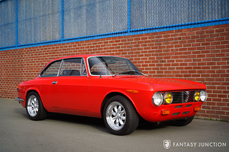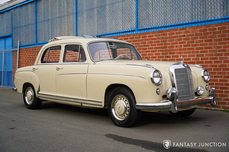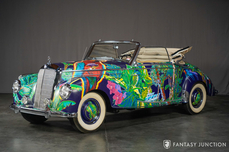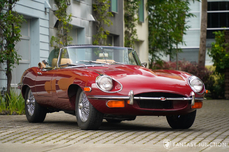Bugatti Typ 46 1931
Allgemeine Beschreibung :
1931 Bugatti Type 46 ‘Superprofile’ Coupe
Evocative Bugatti Coachwork by Ashton Keynes
s/n 46491, Eng. no. 345
Two Tone Blue with Tan Leather Interior
Grand Prix heritage, elegant handmade coachwork, and revolutionary engineering established Bugatti as the premier manufacturer of superb road cars. Born when the auto industry was booming and individual wealth was increasing, Bugatti delivered cars to European royalty, industrial tycoons, and wealthy elites. Despite the decorative vogue and erudite clientele, the brilliantly engineered Bugatti eschewed Art Deco filigree and gaudy ornamentation, instead relying on sumptuous handmade coachwork employing avant garde aerodynamics, refined finishes, and mechanical artistry and innovation to distinguish its cars as some of the most extraordinary ever made.
In 1929, Bugatti revealed the Type 46, a sensational designation that earned the moniker “La Petite Royale” as it shared many similarities with the Royale including the combined rear axle/three-speed gearbox, and the massive long stroke inline 8. The 5.3 Liter engine was a marvel of design. With single overhead camshaft, three valves per cylinder, and twin pulg ignition, the engine produced 140 hp. Power was transmitted through a three-speed transaxle at the rear of the car. The robust chassis utilized front semi-elliptical leaf springs, and rear quarter elliptical leaf springs, with cable operated drum brakes cleverly cast into the impressive alloy wheels. Although launched at a time of significant financial crisis, wealthy clientele responded favorably with Bugatti crafting approximately 400 Type 46s, an impressive figure for such an indulgent and exclusive automobile.
Period press lavished praise on the new Bugatti including The Motor magazine in a 1930 Type 46 review: "A really solidly built, beautifully sprung, comfortable saloon car with exceptionally rapid acceleration through its speed range; that is the 32.5hp or "5-liter" Bugatti. It combines the luxury of a large limousine, the flexibility and top gear performance of a thoroughbred town carriage with the perfect road holding, the speed and acceleration of the best type of sports model...... It will creep through traffic at 3 or 4mph in top gear, will climb practically any main road hill without there being any need to change down, and will accelerate, whenever the opportunity occurs, with surprising rapidity".
Considered by Bugatti historians and enthusiasts to be among the finest and most elegant of the large Bugatti offerings, the Type 46 received a number of different body designs at the hands of Jean Bugatti and in-house Bugatti designer Joseph Walter. Among the most dynamic and advanced of these is the stunning Superprofile. During this period, Jean Bugatti directed the most advanced design to employ a dramatically raked windscreen, forward sweeping fenders with unbroken curved running boards, and aerodynamic roof profile tapering elegantly to the rear of the car. These unified and advanced design characteristics were to become the signature elements of Bugatti design, strongly influencing the Type 57 and Ventoux Coupe years ahead of other coachbuilders who would later integrate aerodynamic ideas into their body designs.
Bugatti also offered the Semi-Profile, a less severe representation of the design with a notchback rear treatment, yet still embodying the Bugatti family look, all of which deeply impacted their subsequent production offerings, ultimately establishing the lasting visual design imprint of the Bugatti mystique. During the period of construction, very few Semi-Profile and Superprofile cars were assembled, with fewer still surviving today. The well-known Semi-Profile of the Louman Collection and the sole example Superprofile of the Cite de l’Automobile, Musee National de l’Automobile, Collection Schlumf, in France, are among the two most notable.
According to the American Bugatti Club journal, Pur Sang Vol. 21, No. 3, in fall 1980, noted Bugatti historian Andy Rheault published a series of letters from Don Stanford to Russ Sceli in 1952 referring to four Bugatti Type 46 chassis including 46482 and 46491 (the subject car). In the article, recollections revealed: 'Richard Baudens' 'is a close friend of Roland Bugatti, Le Maestro's son' 'the Baudens-Bugatti friendship has resulted in a situation you won't believe, but here it is: Long ago, Baudens discovered a couple of brand new Bugatti chassis in Roland's garage and it turned out that there had once been four of 'em; Le Patron's last works, still (these two) in their original crates, 5-liter Bugatti engines complete and never yet turned over' 'Anyway—Roland Bugatti sold the last two crated chassis to Baudens, who shipped them to his garage in Paris, where they are today'.
Indeed, chassis 46482 and 46491 had been sequestered by Roland Bugatti and subsequently purchased by Baudens. Both chassis had distinctly been part of original orders, however chassis number 46491 (the subject car), intended for delivery November 5, 1930, was canceled and the chassis never sold. Chassis 46482, also assumed to have been a cancelled order, would eventually arrive in the states and pass to Eri Richardson who, in the 1950s, had discovered the sole surviving Superprofile body and matched it to that chassis, eventually selling the completed car to Fritz Schlumph. In 1952, Baudens reportedly sold chassis 46491. The chassis changed hands, documented in 1987, to be in the UK where it would remain under the ownership of dealer Charles Howard (UK Bugatti registry 1989).
Chassis 46491 was then sold in 1990 by C.A.R. Howard to an owner in the UK, who retained the car until 1994 but did no major work before selling it at that point to the current custodian. He embarked on a decade long journey to envision the Superprofile Bugatti Type 46 Jean Bugatti had so dearly endeavored to achieve. After his purchase, the current owner, a respected and fastidious collector of French cars, began contemplating exemplary coachwork for this important chassis. Fascinated by the allure of the Semi-Profile design, work began in earnest toward that goal. Slowly, however, the unmistakable daring looks of the Superprofile became the irresistible challenge that beckoned to be fulfilled. During the decade long period of development, work began at Barrie Price’s workshop, then advanced to Keith Bowley’s renown shop, Ashton Keynes Vintage Restoration, whose credits include Tom Weatcroft’s Bugatti Type 41 Royale recreation (built by AKVR from scratch), as well as awards at the world’s foremost concours including Pebble Beach and Villa d’Este. Thus, lovingly fabricating this car’s coachwork to precisely match the original Superprofile body as well within the expertise of AKVR, and the resulting car is nothing short of spectacular.
Having been thoughtfully preserved and cherished for so many years, chassis 46491 is today resplendent wearing the only body ever crafted for this remarkable Bugatti. The Superprofile Bugatti and Walter design has been thoughtfully executed with the utmost care, befitting a car of unmistakable motoring importance, authoritative provenance, and cultural prominence. Modestly used since completion, the car has been featured only briefly at the 2009 and 2010 Salon Privé event at Retromobile in 2010, and The Lawn Classic Car Show, UK in 2012, remaining under careful mechanical and cosmetic stewardship, ready for any North American concours.
Today this majestic Type 46 has the arresting presence resulting from its exquisite construction, restoration, and mechanical excellence realized by the cadre of Bugatti specialists from all over the world who completed this car. The fascinating and beautifully constructed coachwork is sumptuously elegant, featuring flowing fenders, stately upright horseshoe grille, advanced tapered rear, and iconic livery. The gorgeous two-tone paint, is wonderfully elegant dark blue over blue, which captures the fluid form of the upper portion of the body perfectly. The finish is wonderfully done with excellent gloss, superb bodylines, and pristine paint separation lines. The flowing fender line is accented by disc type alloy wheels, which have been polished to a fitting luster. Only minor evidence of use and settling to the still stunning restoration is evident, including a few small chips on the driver’s side rear fender tip, and some minor areas along the cowl. Chrome trim, lighting, and various other polished elements glisten as wonderful bits of exterior jewelry, all sourced as absolutely authentic pieces featuring original lenses and housings, enhancing the elegant body design without detracting from the beauty of the advanced coachwork.
The interior is simply breathtaking, revealing the finest leather upholstery, wood finishes, and tasteful door panel stitching, all accurately restored to the highest standard by expert craftsmen. The interior design is not only elegant, it contains a unified expression of mechanical integrity and delicate refinement, harmonizing in a way only true artisans of this period can achieve. The machined knurling, chronographic instrument detail, rich lacquered wood finishes, and jeweled mechanical armatures deliver a lasting impression of awe and opulence: a fitting tribute to the era of original construction, unprecedented engineering, and a celebration of modern restoration arts.
Lifting the centrally hinged hood, each side of the magnificent inline-8 is a delight of aluminum castings, fabrication brilliance, and engineering artistry from a bygone era. The original engine, essentially unused for decades before being united with coachwork, has a beautiful upright presence enhanced by mechanical details, brass and copper elements, and polished aluminum pieces, all of which come together in a symphony of visual delight. The beautifully shrouded exhaust side of the engine delivers a clean contrast to the more complex intake side, which houses twin plug spark wires, stunning steering box casting, delicately plumbed copper and brass fittings with polished nickel accents, and of course raised letter Bugatti ovals heralded by bright red inlaid paint. Handsomely restored, the engine now exhibits a fine unified patina of lightly toned components conveying the integrity representative of a car that has been cared for but allowed to gracefully mature without becoming a fussy museum artifact.
The car starts easily and delivers a symphony of sophisticated mechanical sounds overlaid with the sonorous straight-8 exhaust note, recalling the Grand Prix heritage so deeply ingrained in the Bugatti name. Once underway, this impressive automobile pulls very well as steering becomes lighter and the car delivers a feelsome and communicative driving experience from the chassis and driveline. Mechanical brakes require a plenty of planning but are extremely reliable with no hydraulic components to suffer from extended storage, for example. There is a brawny and raw mechanical feel to the car that isn’t present in a Type 57, while the reclined seating position and very rakish windshield rake give an unmistakable sense of occasion missing even from a less remarkably styled Type 46. Gear selection is unsynchronized and requires technique typical for these prewar cars, but once mastered, the result is a vintage delight of sights and sounds unlike any other driving experience. Included with the car is a series of large curated notebooks, which extensively document the chassis and the history, including copious photographs showing the construction of the body, restoration details, and reference materials specific to Bugatti.
Exquisitely constructed with one of the most dramatic and advanced body designs to ever grace a prewar automobile, this Bugatti Type 46 delivers all the majesty and elegance of one of the most formidable automobile marques of the twentieth century. Virtually unexposed in North America, this phenomenal expression of artistry is ready for any world-class concours, memorable motoring, or simply to marvel singularly as one of the finest works of automotive art ever constructed.
http://fantasyjunction.com/cars/2196-Bugatti-Type%2046%20'Superprofile'%20%20%20%20%20Coupe-5.4%20Liter%20SOHC%20Inline-8
1931 Bugatti Typ 46 is listed verkauft on ClassicDigest in Emeryville by Fantasy Junction for $795000.
Fakten der Auto
Karosserietyp : Auto Marke : Bugatti Modell : Typ 46 Hubraum : 5.4 Modelljahr : 1931 Karosstyp : Coupé Lage : Emeryville
Verkauft
Angaben Zum Verkäufer
Verkauft
Other cars listed for sale by this dealer
über Bugatti
Ettore Bugatti, in Mailand geboren, in Molsheim Teil des Deutschen Reiches gründete das Automobilunternehmen, das seinen Namen im Jahr 1909 dann bis 1919.Bugatti wurde sowohl für den Detailgrad der Technik und für die ihre Jugendstil-Design bekannt.
Im Laufe der Jahre produzierte sie eine Reihe von Luxus-Autos, wie Bugatti Royale, sowie einige der berühmtesten Rennwagen. Bugatti Typ 35 ist wahrscheinlich der erfolgreichste Rennwagen aller Zeiten, mit mehr als 2.000 Positionen Essen.
Der Tod von Ettore Bugatti Sohn Jean Bugatti, während ein Typ 57 Tank-bodied Rennwagen testen, markiert einen Wendepunkt in die Geschicke des Unternehmens. Ettore Bugatti starb am 21. August 1947 Nach dem Tod von Ettore Bugatti im Jahr 1947 das Geschäft weiter rückläufig und Bugatti schließlich den Betrieb eingestellt im Jahr 1952.






